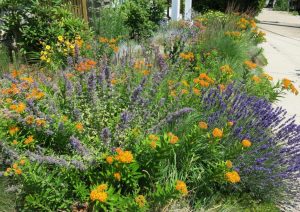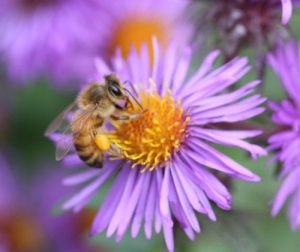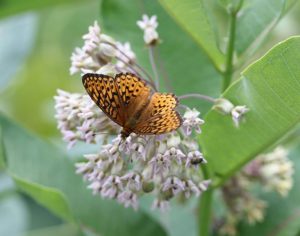planting A Garden
How can you help promote pollinator abundance? Plant a garden! When planting a pollinator garden there are many factors that go into its success. Pollinator patches are home to plants that promote pollinator visitation to the area. Once these gardens are planted, pollinators will return and find a home in these gardens for years to come; and hopefully help fight pollinator declines.

Sundberg, Maureen. “Butterfly Milkweed” [1]
Plants and pollinators have evolved together, and patterns of that coevolution remain. If you are aiming to attract a certain type of pollinator, take a look at a pollination syndrome chart like the one found here (5). Pollinator syndromes are the patterns of flower characteristics of each plant that have evolved with a pollinator in order to promote interactions (2). You can take advantage of these to get the pollinators you want. If you want hummingbirds, choose plants that have red flowers. If there is a certain pollinator you want to give a home, remember to pay attention to its pollinator syndrome.
Another important factor when creating your garden is diversity. Cater to the needs of all pollinators and their life stages. Some pollinators can visit a variety of plants while others are subject to only a few. For instance, plants such as Milkweed and Goldenrod attract a diverse range of pollinators(1). Limiting the range of plants you have will limit the number of pollinators you are able to support
While selecting your variety of native plants, make sure to clear the area of invasive species and avoid aesthetic landscaping tools such as mulch(1). The invasive plants are not native and will not attract pollinators as well. They will also take over your garden and inhibit native plant growth. Meanwhile, by avoiding mulch, unintentional weeds should not be an issue.
More tips to making a garden

Sundberg, Maureen. “Honey Bee on an Astrid” [1]
- Choose a variety of native plants for your garden.
- Place the plants far enough apart so that they have room to grow.
- Using a variety of plants ensures that at least part of your plot throughout the year.
- Avoid plants that have been cultivated or hybridized, such as roses, that make it hard for pollinators to reach the pollen. (1)
- Never use pesticides.
Leave the dead stuff!
Leaving dead plants gives pollinators a way to make shelter. Old wood, leaf piles, and dead stalks all provide winter homes for these organisms. removing them only hurts our local pollinators.

Sundberg, Maureen. “Butterfly on Milkweed” [1]
Read more about our local pollinators and what is happening to them here:
Literature Cited
(1) Schmotzer , Constance. “Planting Pollinator-Friendly Gardens.” Penn State Extension, 26 Apr. 2018, extension.psu.edu/planting-pollinator-friendly-gardens.
(2) Sundberg, Maureen, and Tara Mitchell. “More than Just a Pollinator Garden.” Ecological Landscape Alliance, 14 Dec. 2016, www.ecolandscaping.org/11/landscaping-for-wildlife/wildlife-habitats/more-than-just-a-pollinator-garden/.
(3) U.S. . “Pollinator Syndromes.” Forest Service Shield, www.fs.fed.us/wildflowers/pollinators/What_is_Pollination/syndromes.shtml.
(4) Xerces. “Bring Back the Pollinators.” Xerces Society, www.xerces.org/bring-back-the-pollinators.
(5) Pollinator Partnership. (2010.). About pollinators. Pollinator.org. Retrieved November 17, 2021, from https://www.pollinator.org/pollinators.
Image Credits
[1] Sundberg, Maureen, and Tara Mitchell. “More than Just a Pollinator Garden.” Ecological Landscape Alliance, 14 Dec. 2016, www.ecolandscaping.org/11/landscaping-for-wildlife/wildlife-habitats/more-than-just-a-pollinator-garden/.
C.C. made this webpage to increase plant appreciation as part of Wooster’s Field Botany course in Fall 2021